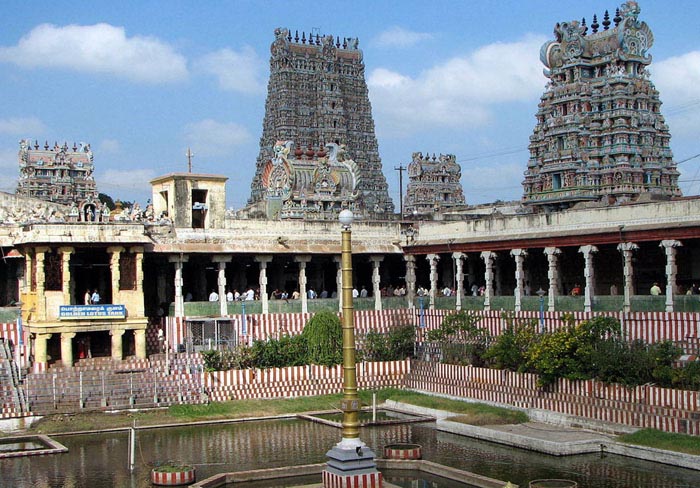Meenakshi Amman Temple Madurai (Meenakshi Sundareswarar Temple)

Information of Meenakshi Amman Temple (Meenakshi Sundareswarar Temple), Madurai, Tamil Nadu
This temple is also known by other names such as Meenakshi Sundareswarar temple, Tiru-Aalavaai and Meenakshi Amman Kovil Gopuram. This temple is located on the southern banks of the river Vaigai and is known to one of the most revered temples in Madurai, Tamil Nadu. The temple is dedicated to Goddess Parvati and her consort Lord Shiva. The goddess Parvati is known as Meenakshi and Lord Shiva as Sundareswarar as a result the temple is known by the name Meenakshi Sundareswarar. The temple is an ancient one and has a lot of historical significance as it is known to be the lifeline of the city of Madurai which dates back almost 2500 years. The temple was also shortlisted for the 7 wonders of the world due to the grandness and antiquity of the temple.
Meenakshi Amman Temple Religious Significance
The temple unlike other temples dedicated to Lord Shiva does not recognise him as the principal diety. In this temple his consort goddess Parvati is the main diety. This temple is unique in the sense that the idols of Parvati and Shiva are much different that the other temples. In case of Goddess Parvati one can see a parrot perched on her right hand while the Natraja statute of lord Shiva depicts him raising his right leg instead of the normal left leg. The parrot is associated with Saint Andal who is Vaishnava azhwar. The Natraja statue of Shiva is enclosed within a silver altar and differs from the bronze figurines of Chola dynasty which have their left leg raised. It is said in the Tiruvilayaadai Puranam that this figure has its right leg raised on request of Rajasekara Pandya a devotee of Lord Shiva. It is believed that the diety was asked to change his posture as he felt that raising the same foot would put enormous strain on his lord.
The temple is home to about 50 priests who perform the daily pujas and rituals. However the main festival of this temple is the Meenakshi Thirukalyanam meaning the divine marriage of Meenakshi. This festival is celebrated during the month of April every year and is a grand affair.
Meenakshi Amman Temple Mythology & History
There are two legends attached to the temple. One legend suggests that goddess Parvati appeared out of the holy fire of the Kameshti Yagna which the Pandya king Malayadwaja and his wife Kanchanamalai performed. Another legend suggests that the goddess herself appeared to the queen and told her that she would be born to the queen. The queen gave birth to a girl who had three breasts. The king was told not to worry about the abnormality by the divine voice from the skies. It was said that the third breast would vanish as soon as she met her future husband. The king named the girl "Tadaatgai" and placed her as the heir to his throne. She was trained in the field of science known as the 64 sastras. During the coronation time of Tadaatgai she had to wage war in three worlds that encompassed eight directions, she was successful in all her campaigns. She had captured the abodes of Brahma, Vishnu and Devas however when she was on her way to Kailash which is Shiva's abode, she was unable to fight on seeing Shiva. Her third breast also disappeared and she knew that he was to be her future husband. Realization of being an avatar of Parvati also dawned on her, they then returned to her kingdom to get married. The marriage was to be a grand one with the whole earth being invited to Madurai and after the marriage the couple ruled over Madurai.
Meenakshi Amman Temple Architectural Significance
The temple complex is a large one. It has been built in the Dravidian style of architecture and has excellently carved gopurams. This temple is built in accordance with the principles of Shilpa Shastras and is one of the few temples in Tamil Nadu that has four entrances. It has a total of 10 gopurams and the tallest one is the southern tower that rises 170 feet and was built in the year 1559. There are two shrines for the two gods and one for lord Ganesh. There is a hall that has 1000 pillars which have been sculpted very artistically. In total there are nine halls which have different significance and functions.
- Andhra Pradesh Temples
- Assam Temples
- Bihar Temples
- New Delhi Temples
- Goa Temples
- Gujarat Temples
- Jammu and Kashmir Temples
- Karnataka Temples
- Kerala Temples
- Madhya Pradesh Temples
- Maharashtra Temples
- Odisha Temples
- Punjab Temples
- Rajasthan Temples
- Sikkim Temples
- Tamil Nadu Temples
- Telangana Temples
- Uttar Pradesh Temples
- Uttarakhand Temples
- West Bengal Temples